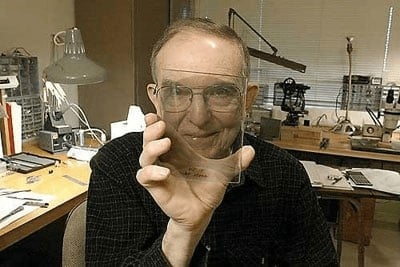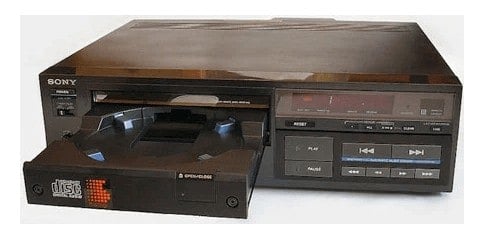Compact Disc History
The first workable digital compact disc device, the precursor to now-ubiquitous CD/DVDs, was invented in the late 1960s by the American physicist James Russell.
In 1953, Russell earned his Bachelor’s degree in physics and graduated from Reed College in Portland. Afterward, he worked as a Physicist in General Electric’s nearby labs in Richland, where his wife Barbara worked as a chemist. At GE, working for the Hanford Nuclear Plant and appointed as a “designated problem-solver” for the GE experimental unit, Russell initiated many practical instrumentation projects. He was among the first to use a color TV screen and keyboard as the primary interface between computer and operator. He also designed and built the first electron beam welder.
Quick Facts
- Created
- October 1982
- Creator (person)
- James Russell
- Original Use
- Audio and data storage
- Cost
- $1,000 in 1982

In the 1950s and early 1960s, Russell, an avid music listener entirely frustrated with the wear and tear of his vinyl records and their poor sound quality, tried to improve the record player. Initially, he tried using a cactus needle, instead of a steel one, for a stylus, but with no success.
Alone at home on a Saturday afternoon, he suddenly realized that the wear and tear on the records due to the contact from the stylus to the record could be avoided by using a light to read the music without physically touching the disk. Moreover, as he was familiar with digital data (in a punch card or magnetic tape form), he could digitally accomplish this task more efficiently and effectively. He realized that if he could make the binary code compact enough, he could store not only symphonies but entire encyclopedias on a small piece of film.
In 1965, the Ohio-based Battelle Memorial Institute opened its Pacific Northwest Laboratory in Richland, took over management of Hanford’s lab, and James Russell joined the effort as Senior Scientist. Thus, he gained an audience for his more far-fetched ideas and immediately peppered Battelle with proposals for new commercial concepts.
The digital optical technology was initially met with skepticism, as it was not believed that one could digitize sound. However, Battelle eventually let Russell pursue the project, and after years of work, he succeeded in inventing the first digital-to-optical recording and playback system (the earliest patent by Russell, US3501586, was filed in 1966 and granted in 1970).

Russell had found a way to record onto a photosensitive platter in tiny “bits” of light and dark, each a micron in diameter. A laser read the small pits (binary patterns), and a computer converted the data into an electrical signal, which was then comparatively simple to transform into an audible or visible transmission.
Through the 1970s, Russell continued to refine the CD-ROM, adapting it to any form of data. However, like many ideas far ahead of their time, the CD-ROM found few interested investors at first. Finally, in 1971, Eli S. Jacobs, a New York venture capitalist, pioneered commercialization by forming Digital Recording Corporation to further enhance the product for the consumer video market and hired Russell and a team of technicians to develop a video disk. Their efforts led to a 20-minute video disc in 1973.
In 1974 Digital Recording Corporation announced an optical digital television recording and playback machine, the first device to digitize a color image, at a Chicago trade show. The response from large potential investors was relatively cool.
Philips Electronics representatives visited Russell’s Battelle lab in the summer of 1975, and they discounted the entire premise of his work. They said: It’s all very well for data storage, but you can’t do that for video or audio. Philips had just released its laser disc, an analog optical video player, and they were convinced that analog was the only way.

Sony launched its CDP-101 – the first commercialized CD player in 1982. Sony and Philips paid royalties from CD player sales to Battelle and Optical Recording Corporation. Time-Warner and other disc manufacturers settled with the Optical Recording Corporation in 1992, paying $30 million for patent infringement. The court determined that Optical Recording had the sole rights over the technology mentioned in the patents. But because the patents properly belonged to Russell’s employer, he never got a cent out of either deal.
Compact Disc: How It Worked
Compact discs are portable storage devices used for recording, storing, and playing video, audio, and other forms of digital data. So how does the compact disc work?
Whenever a CD is played, a laser beam focuses on the CD’s data track as it rapidly spins around; the laser beam reflects differently off the aluminum layer of the CD — the sensor detects such different levels of reflections. These multiple reflections are after that converted into digital information, interpreted as music, video, or whatever digital media it may be.
This process happens quickly and as accurately as possible, making compact disc technology a significant revolution in how humans share digital content.

Compact Disc: Historical Significance
By 1985, Russell had earned 26 patents for CD-ROM technology. He then founded his own consulting firm, where he has continued to create and patent improvements in optical storage systems, along with bar code scanners, liquid crystal shutters, and other industrial optical instruments. His most recent invention is a high-speed optical data recorder and player with no moving parts. Russell earned another 11 patents for this “Optical Random-Access Memory” device.
Generally, since reaching a touted peak in 2008, compact disc sales have been on a considerably significant decline, falling by approximately 10 million yearly.
This can be attributed to the invention of a few other audio and video storage and playback devices. For instance, in 2001, Apple launched iTunes, a platform where humans can buy and play songs online without owning a compact disc; Spotify was also launched in 2008, a platform where people can stream unlimited songs for a subscription fee, etc.
Although compact discs have served multiple purposes over the years, since their invention, the technology is gradually fading behind the scene, allowing other updated ways to store, play, and share digital media. Compact disk technology also led to digital video recording and DVDs.
Fun Facts:
- The Visitors, an album by Abba, a Swedish pop group, was the first-ever created compact disc.
- The Eagles 1976 album is the most-sold CD ever, with over 38 million copies sold.
- Compact discs are 1.2mm thick with a diameter of 120mm.
The image featured at the top of this post is ©Atreyu, CC BY 3.0, via Wikimedia Commons.
